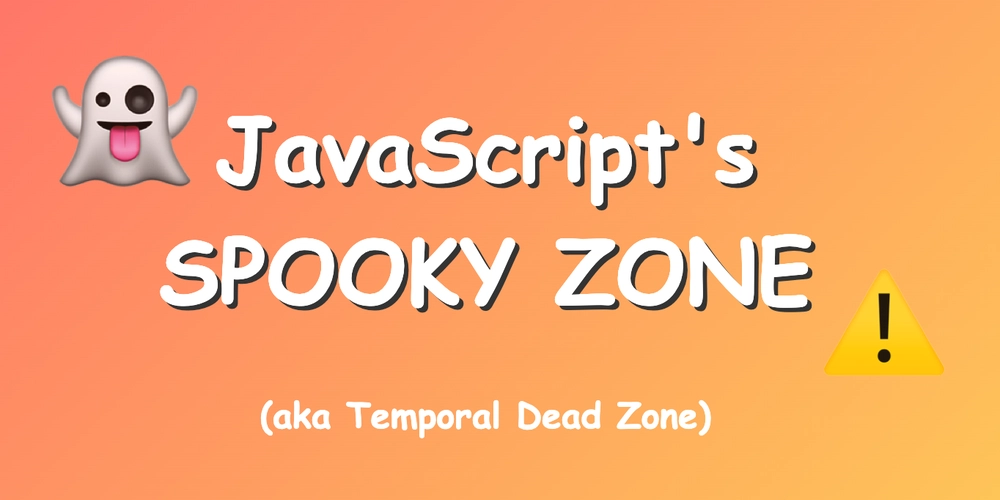Temporal Dead Zone in JavaScript: WTF Is It & Why Should You Care?
Ever heard of the Temporal Dead Zone (TDZ) in JavaScript? Sounds like some sci-fi term, right? Well, it’s actually a real thing in JS, and understanding it can save you from weird bugs. Let’s break it down—no jargon, just plain fun talk! What the Heck Is TDZ? Imagine you declare a variable with let or const, but try to use it before its declaration. Boom! You’ve entered the Temporal Dead Zone—a fancy way of saying: "Hey, this variable exists, but you can’t use it yet!" Example Time! console.log(myName); // ❌ Throws an error! let myName = "Dev"; Here’s what happens: The variable myName is hoisted (JS knows it exists). But it’s in the TDZ until the let myName = "Dev" line runs. Trying to use it before that line? Error! Why not just return undefined like var? Because TDZ helps catch bugs early—forcing you to write cleaner code. Why Does TDZ Exist? Good question! TDZ was introduced with let and const to make our code more predictable. Before ES6, var had weird hoisting behavior: console.log(age); // undefined (no error, but confusing!) var age = 25; This was messy because: Variables were hoisted but set to undefined. Bugs were harder to catch since no error was thrown. let & const Fix This With let and const, JS introduced TDZ to make variable access more predictable: console.log(age); // ❌ ReferenceError (TDZ in action!) let age = 25; Key Takeaway: var → Hoists & initializes as undefined. let/const → Hoists but stays in TDZ until declared. Why Should You Care About TDZ? 1. Avoid Hidden Bugs With var, silent undefined issues could creep in. TDZ forces you to declare variables before using them, making your code more reliable. 2. Better Debugging Instead of mysterious undefined values, TDZ throws a clear ReferenceError, helping you spot mistakes faster. 3. Modern JS Best Practice Most codebases now use let/const. Understanding TDZ helps you: Write cleaner, more predictable code. Avoid pitfalls when refactoring old var code. How to Escape the TDZ? Simple rule: Always declare variables at the top of their scope! ✅ Good: Declare First, Use Later let myPet = "Dog"; console.log(myPet); // "Dog" (No TDZ here!) ❌ Bad: Using Before Declaring console.log(myPet); // ❌ TDZ error! let myPet = "Dog"; Pro Tip: Use const for values that shouldn’t change. Use let for variables that need reassignment. Avoid var in modern JS—it’s outdated. Final Thoughts TDZ isn’t scary—it’s JavaScript’s way of keeping your code clean and error-free. By using let and const properly, you avoid weird bugs and write more reliable code. So next time you see a ReferenceError, check if you’re stuck in the Temporal Dead Zone!

Ever heard of the Temporal Dead Zone (TDZ) in JavaScript? Sounds like some sci-fi term, right? Well, it’s actually a real thing in JS, and understanding it can save you from weird bugs. Let’s break it down—no jargon, just plain fun talk!
What the Heck Is TDZ?
Imagine you declare a variable with let or const, but try to use it before its declaration. Boom! You’ve entered the Temporal Dead Zone—a fancy way of saying:
"Hey, this variable exists, but you can’t use it yet!"
Example Time!
console.log(myName); // ❌ Throws an error!
let myName = "Dev";
Here’s what happens:
- The variable
myNameis hoisted (JS knows it exists). - But it’s in the TDZ until the
let myName = "Dev"line runs. - Trying to use it before that line? Error!
Why not just return undefined like var? Because TDZ helps catch bugs early—forcing you to write cleaner code.
Why Does TDZ Exist?
Good question! TDZ was introduced with let and const to make our code more predictable.
Before ES6, var had weird hoisting behavior:
console.log(age); // undefined (no error, but confusing!)
var age = 25;
This was messy because:
- Variables were hoisted but set to
undefined. - Bugs were harder to catch since no error was thrown.
let & const Fix This
With let and const, JS introduced TDZ to make variable access more predictable:
console.log(age); // ❌ ReferenceError (TDZ in action!)
let age = 25;
Key Takeaway:
-
var→ Hoists & initializes asundefined. -
let/const→ Hoists but stays in TDZ until declared.
Why Should You Care About TDZ?
1. Avoid Hidden Bugs
With var, silent undefined issues could creep in. TDZ forces you to declare variables before using them, making your code more reliable.
2. Better Debugging
Instead of mysterious undefined values, TDZ throws a clear ReferenceError, helping you spot mistakes faster.
3. Modern JS Best Practice
Most codebases now use let/const. Understanding TDZ helps you:
- Write cleaner, more predictable code.
- Avoid pitfalls when refactoring old
varcode.
How to Escape the TDZ?
Simple rule: Always declare variables at the top of their scope!
✅ Good: Declare First, Use Later
let myPet = "Dog";
console.log(myPet); // "Dog" (No TDZ here!)
❌ Bad: Using Before Declaring
console.log(myPet); // ❌ TDZ error!
let myPet = "Dog";
Pro Tip:
- Use
constfor values that shouldn’t change. - Use
letfor variables that need reassignment. - Avoid
varin modern JS—it’s outdated.
Final Thoughts
TDZ isn’t scary—it’s JavaScript’s way of keeping your code clean and error-free. By using let and const properly, you avoid weird bugs and write more reliable code.
So next time you see a ReferenceError, check if you’re stuck in the Temporal Dead Zone!









































































































































































![[The AI Show Episode 142]: ChatGPT’s New Image Generator, Studio Ghibli Craze and Backlash, Gemini 2.5, OpenAI Academy, 4o Updates, Vibe Marketing & xAI Acquires X](https://www.marketingaiinstitute.com/hubfs/ep%20142%20cover.png)


























































































































![[FREE EBOOKS] The Kubernetes Bible, The Ultimate Linux Shell Scripting Guide & Four More Best Selling Titles](https://www.javacodegeeks.com/wp-content/uploads/2012/12/jcg-logo.jpg)



![From drop-out to software architect with Jason Lengstorf [Podcast #167]](https://cdn.hashnode.com/res/hashnode/image/upload/v1743796461357/f3d19cd7-e6f5-4d7c-8bfc-eb974bc8da68.png?#)







































































































.png?#)




.jpg?#)




















 (1).webp?#)











_Christophe_Coat_Alamy.jpg?#)








































































































![Rapidus in Talks With Apple as It Accelerates Toward 2nm Chip Production [Report]](https://www.iclarified.com/images/news/96937/96937/96937-640.jpg)








































































































































